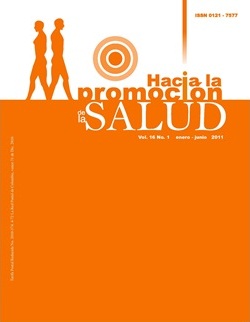Authors
Abstract
Objective: to characterize the adverse events happening in a first-level hospital in the Department of Caldas between 2007 and 2009. Materials and methods: a cross-sectional retrospective descriptive study was performed which analyzed the information obtained during the adverse events (AE) registered between 2007 and 2009 in a first level hospital in the Department of Caldas. An EA data report of the institution was revised which contained 112 records. 63 records were highlighted and those that could be evaluated from the medical record (49) were selected. They were applied an instrument though which social-demographic, characteristics of the event and quality of the record variables were identified. Results: from the AE recorded, 38 cases corresponded to females and 11 cases to males. The most frequent AE were obstetric events (40.8%) and death as a result of lack of attention (16.3%); the least frequent cases were failures in safety (2.0%); 18.4% were deaths depending on seriousness of disease, 57.1% were slight events and 8.2% were moderate events. In 30.6% of the cases management was not established; in 22.4% of the cases small surgery was applied and in 20.4% other procedures were applied. As far as quality of records is concerned, 32.6% were bad, 44.8% were average, and 20.4% were high quality. Conclusions: 100% of the adverse events did not have individual proceeding records. Only one report of the most relevant AE was available but it neither implies a follow up of the event nor contains specific data of the situation or the patient.
References
Ministerio de la Protección Social. Resolución número 1446 de 2006. Bogotá: Ministerio de la Protección Social, M.P.S; 2006.
Ministerio de la Protección Social. Anexo Técnico Resolución numero 1446 de 2006. Bogotá: Ministerio de la protección social, M.P.S; 2006.
Villareal E. Seguridad de los pacientes. Un Compromiso de Todos para un cuidad de calidad. Salud Uninorte Barranquilla 2007;23(1):112-19.
Weingart S, Wilson R, Gibberd R, Harrison B. Epidemiology of Medical Error. BMJ. 2000;320:774-7.
Mena P. Error Médico y Eventos Adversos. Rev Chil Pediatr 2008; 79(3): 319-26.
Franco A. La seguridad clínica de los pacientes: entendiendo el problema. Colomb Med 2005; 36:130-3.
Ministerio de la Protección Social. Anexo Técnico Resolución numero 1043 de 2007. Bogotá: Ministerio de la Protección Social, M.P.S; 2007.
“Estudio IBEAS: Prevalencia de Efectos Adversos en Hospitales de Latinoamérica” Informe final. Octubre 2008.
Gaitán H, Eslava J, Garzón C, Rubio J, Forero J, Valvuena L, et al. Tamizaje de Eventos Adversos en Atención Obstétrica Y del Puerperio en el Instituto Materno-Infantil de Bogotá, Colombia. 2002-2003. Rev Colomb Obstet Ginecol 2005;56(1): 18-27.
Gaitán H, Eslava J, Rodríguez N, Forero B, Santofimio D, Altahona H. Incidencia y Evitabilidad de Eventos Adversos en Pacientes Hospitalizados en Tres Instituciones Hospitalarias en Colombia. 2006. Rev Salud Pública 2008;10(2):215-26.
Cumming RG, Sherrington C, Lord SR, Simpson JM, Vogler C, Cameron ID, et al. Prevention of Older People’s Injury Falls Prevention in Hospitals Research Group. Cluster Randomised Trial of a Targeted Multifactorial Intervention to Prevent Falls Among Older People in Hospital. BMJ 2008;336:758-760.
Estudio Nacional de Efectos Adversos ligados a la hospitalización. ENEAS 2005.. Madrid: Ministerio de Sanidad y Consumo; 2006.
Kettle C, Hills RK, Jones P, Darby L, Gray R, Johanson R. Continuous versus interrupted repair with standard or rapidly absorbed sutures after spontaneous vaginal birth: a randomized controlled trial. Lancet 2002;(359):2217-23.
Ferreira, S. Gonzales ML. Randomized controlled clinical trial on two perineal trauma suture techniques in normal delivery. Rev Latino-am Enfermagem 2008 marzo-abril; 16(2):272-9.


 PDF (Español)
PDF (Español)
 FLIP
FLIP






















